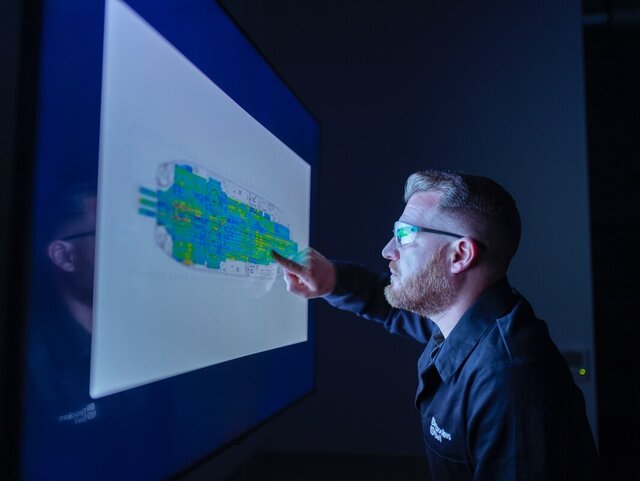Surface inspection is an important part of maintaining the condition and life span of an asset.
Used to detect discontinuities such as cracks, stresses, corrosion and more, the best surface inspection technologies will provide a true picture of the real condition of your asset.
Here at The Lab, our electromagnetic surface inspection technologies are ideal for inspecting assets such as decking, superchargers & turbines, gears, pressure vessels, cargo tanks and tanktainers - whether that’s direct to metal or through coatings.
Eddy Current Array (ECA)
Eddy current array (ECA) is a natural extension of eddy current testing (ECT) that improves ECT technology by using multiplexed arrays of coils arranged in rows (instead of one or two coils).
If you have a metallic surface that needs to be inspected for corrosion, damage or wear, The Lab can help.
ECA can cover larger areas much faster and with greater sensitivity than ECT, using single scan passing to detect surface-breaking cracks as small as 0.5mm and sub-surface defects to a penetration depth of 6mm or more.
The benefits of using ECA over single-element ECT include:
- Faster inspections
- Wider coverage
- Better defect detection, characterisation and monitoring
- Simpler ECA scan patterns, enabling easier and more accurate analysis
- Improved defect positioning and sizing due to encoding of inspection data
- Easier inspection of hard-to-reach areas and complex geometries
- Fully recordable, robust data sets enabling improved decision making
- Post-inspection analysis capability
- 3D advanced imaging of defects
- Effective through coatings and paints
The Lab’s ECA technology has a number of useful applications, and can be used to inspect:
- Corrosion in plate, pipe, casting and forgings
- Deck wear
- Turbines
- Gears
- The integrity of tank containers (tanktainers)
ECA has a range of typical detection capabilities which improve upon traditional NDT inspection methods such as magnetic particle testing (MT), liquid penetrant testing (PT) and single-element ECT.
The table below shows how ECA compares to these traditional NDT inspection methods:
PT | MT | ECT | ECA/TECA | |
Effective on coatings/paintings | No | Yes | Yes | Yes |
Computerised record keeping | No | No | Partial | Yes |
3D/Advanced imaging | No | No | No | Yes |
User dependence | High | High | High | Low |
Speed | V Low | V Low | V Low | V High |
Cleaning | No | No | No | Yes |
Post-inspection analysis | No | No | No | Yes |
Chemicals/consumables | Yes | Yes | No | No |
Turbines
Being highly critical assets that are complex and costly to shut down, it’s vital that you inspect turbines regularly.
The Lab’s ECA surface technology enables fast and accurate inspections of turbine components, including:
- Dovetails
- Blades (leading edge, gas path, root)
- Generator slots
- Retaining rings
- Rotor bores
- Boreholes
Gears
Gears are critical components both onshore and offshore in a variety of equipment such as jack-up legs, crane slew bearings, girth gears, pinions, bull gears and drive trains.
Safety and life-cycle considerations require close monitoring of each gear for surface-breaking cracks caused by stress during operation.
Use of the ECA Gear Probe saves time and money over conventional inspection techniques due to:
- Single pass crack detection
- Greater sensitivity to small surface defects than magnetic particle testing (MT), penetrant testing (PT) and ultrasonic testing (UT) because of the way eddy currents propagate inside conductive materials, such as those used in gears
- Inspection data displayed as 2D and 3D C-scans – allowing easier identification/interpretation of defects
- Recordable data, enabling better reporting
- Better and more accurate analysis capability
- Detection capability of 0.5mm for surface-breaking cracks
The integrity of tank containers (tanktainers)
Stainless steel is a widely used alloy and can be found in various industrial sectors ranging from medical to marine, such as cargo tanks, pressure vessel and tanktainers
Although stainless steel has a reputation for being corrosion resistant, corrosion can still take place and should the alloy be exposed to certain acids or other chemicals that contain chlorides and fluorides, corrosion can occur. Understanding this behaviour and being able to assess the amount of corrosion present is key to ensuring asset integrity and functionality.
Detecting corrosion using conventional methods can be costly and time-consuming, especially if an asset (such as an ISO tank container) requires downtime. It can also be impractical for larger assets, such as chemical products tankers and pressure vessels.
The current approach to detecting pitting and potential issues in stainless steel storage tanks are:
- Visual Testing (VT): inspectors look at the surface of a material or structure to identify any obvious defects, such as cracks or corrosion.
- Liquid Penetrant Testing (PT): involves applying a liquid dye to the surface of a non-porous material. The dye seeps into any cracks, and after removing the excess dye,
The issues with the current approach which are based on visual inspections are:
- The findings are subjective.
- It is difficult to maintain any degree of sensitivity.
- The visual inspection provides limited information of the extent of any defect which is identified.
- There is no robust record to rely on for future inspections.
- If a dispute occurs the inspection findings are refutable and can be easily challenged.
If you need to detect pitting corrosion, stress corrosion cracking and fatigue on your assets with minimal costs, downtime and delay, then The Lab’s eddy current array (ECA) scanning services can help.
Our cargo tank, pressure vessel and tanktainer inspection services include:
- Phased array ultrasonics.
- Eddy current arrays.
- Time of flight diffraction.
- Pulsed eddy current arrays.
The Lab: your go-to for surface inspections
To find out more about The Lab at Brookes Bell’s surface inspections contact us now.
